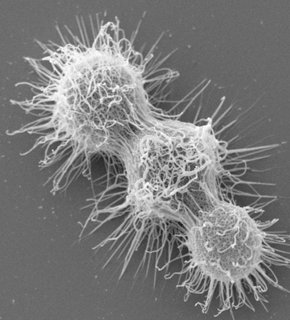Basic Research on a Fungus Yields a Novel Anti cancer Strategy
An enigmatic virulence factor in C. neoformans led to design of a radiation-armed melanin-targeting monoclonal antibody against melanoma tumors.
A melanin-binding monoclonal antibody armed with killing doses of radiation has been successfully deployed against human melanoma cells in vivo, proved therapeutic in mice implanted with human tumors and recently shown promise in patients with metastatic melanoma, according to Arturo Casadevall at the Albert Einstein College of Medicine in New York. This novel anti-cancer strategy is a serendipitous result of basic research on a radiation-eating fungus called Cryptococcus neoformans, he says, noting that "some of the most useful drugs we have were found in unexpected places."

Since it's normally confined inside cells and antibodies attach to cell-surface antigens, melanin has been considered an unlikely candidate for antibody therapy. Moreover, melanoma has so far proved a radiation-resistant cancer because tumor-destroying levels delivered the usual way are too risky for the patient. "However, melanomas are rapidly growing tumors so it seemed logical to us that cell turnover and lysis would release melanin and once the pigment was outside the cells we thought it could be a very good target [for direct delivery of high-dose radiation therapy]," explains Casadevall.
C. neoformans escapes predators including human macrophages with melanin
In the wild, C. neoformans scavenges chemicals from the environment and other microbes to synthesize the dark pigment that enables them to use electromagnetic radiation as an energy source and evade predation by amoebae. In humans, melanin helps C. neoformans escape killing by amoeba-like cells such as macrophages, making this ubiquitous soil fungus a major pathogen in patients with other immune deficiencies --those infected with human immunodeficiency virus (HIV), for example.
Melanin-seeking armed antibodies target pigmented tumors
In an effort to treat patients with cryptococcosis, Casadevall and colleagues designed polysaccharide-binding antibodies, armed them with killing doses of particulate radiation and sent them in search of C. neoforman cell surface antigens. In contrast to electromagnetic radiation, the particulate form directly damages the fungus, Casadevall explains, noting that antibody-delivered particulate radiation has already proved more effective than amphotericin B in infected mice.
Because fungal and human melanins have similar structures and both are negatively charged, Casadevall and colleagues reasoned that an antibody targeted at the fungal pigment would also bind to tumor melanin and provide a suitable vehicle for the delivery of therapeutic doses of radiation. Using an antibody to deliver radiation, called "radioimmunotherapy" or simply "RIT" has proved effective for malignancies including leukemia and lymphoma and is currently experiencing a therapeutic renaissance, says Ekaterina Dadachova, the Einstein study's lead scientist in whose laboratory the RIT-melanoma experiments were done and then brought to clinical trial.
"Appropriately delivered, RIT targeting melanin induces cell death by both direct cell-cycle arrest and bystander effect," Dadachova notes. Antibody-targeting delivers a "direct hit" of radiation to fungal cells and "cross-fire" from radiation-emitting antibodies bound to released melanoma pigment indirectly destroys intact tumor cells. However, the "cross-fire" effect of antibody-delivered radiation could also help combat fungal biofilms, she adds.
Resistance to antibody-delivered radiation by either fungus or cancer cells considered unlikely
"There are no reports of pathogen resistance to RIT and melanin targeting won't spare tumor cells without melanin, thus resistance by either seems unlikely," says Einstein's Joshua D. Nosanchuk, who participated in the research on both cryptococcosis and melanoma. "Even cells without melanin within the tumor are susceptible to killing by the ‘cross-fire' effect of radiation," he explains. Importantly, because of their high degree of cell turnover, the most rapidly growing, aggressive tumors are the most susceptible to destruction by RIT-armed melanin-targeting antibodies.
"Hence, very basic studies on a fungal virulence factor led us, unexpectedly, to the use of melanin as a fundamentally different antifungal and anticancer target as well as dispelling forever the notion that melanoma is a radiation-resistant tumor," says Casadevall who described the latest work of this collaborative group of scientists at the New York Academy of Science-sponsored conference, Discovering Antibacterial and Anticancer Therapeutics in Unexpected Places. In conclusion he noted that "novel therapies often arise from non-directed basic research and societies that fund basic science robustly can expect a rich harvest of new pharmaceutical agents."
References:
- The Casadevall Laboratory | Albert Einstein College of Medicine: http://www.einstein.yu.edu/labs/arturo-casadevall/default.aspx
- Bryan RA, Jiang Z, Howell RC et al. Radioimmunotherapy is More Effective than Antifungal Treatment in Experimental Cryptococcal Infection. J. Infect. Dis. 202(4): 633-7.
- Chrisman CJ, Alvarez M, Casadevall A. Phagocytosis of Cryptococcus neoformans by, and nonlytic exocytosis from Acanthamoeba castellanii. Applied and Environmental Microbiology; 18:6056-6062.
- Dadachova E, Revskaya E, Sesay MA et al. Pre-clinical evaluation and efficacy studies of a melanin-binding IgM antibody labeled with (188)Re against experimental human metastatic melanoma in nude mice. Cancer Biol. Ther. 7(7): 1116-1127 https://www.einstein.yu.edu/dadachovalab/home.html
- Dadachova E, Nosanchuk J.D., Shi L, et al. Dead cells in melanoma tumors provide abundant antigen for targeted delivery of ionizing radiation by a monoclonal antibody to melanin. Proc Natl Acad Sci USA, 101, p.14865-14870.
- Frases S, Salazar A, Dadachova E, Casadevall A. Cryptococcus neoformans Can Utilize the Bacterial Melanin Precursor Homogentisic Acid for Fungal Melanogenesis. Applied and Environmental Microbiology; 73:615-621. (doi: 10.1128/AEM.01947-06)
Congratulations! This post has been upvoted from the communal account, @minnowsupport, by aibek from the Minnow Support Project. It's a witness project run by aggroed, ausbitbank, teamsteem, someguy123, neoxian, followbtcnews, and netuoso. The goal is to help Steemit grow by supporting Minnows. Please find us at the Peace, Abundance, and Liberty Network (PALnet) Discord Channel. It's a completely public and open space to all members of the Steemit community who voluntarily choose to be there.
If you would like to delegate to the Minnow Support Project you can do so by clicking on the following links: 50SP, 100SP, 250SP, 500SP, 1000SP, 5000SP.
Be sure to leave at least 50SP undelegated on your account.